ICISC
2007
14 years 28 days ago
2007
Pairing based cryptography is a new public key cryptographic scheme. An elliptic curve suitable for pairing based cryptography is called a “pairing-friendly” elliptic curve. Af...
ICISC
2007
14 years 28 days ago
2007
We present a collision attack on the hash function HAS-160 reduced to 53-steps. The attack has a complexity of about 235 hash computations. The attack is based on the work of Cho e...
ICISC
2007
14 years 28 days ago
2007
Abstract. Mutual authentication mechanisms can be used in RFID systems to preserve the confidentiality of the RFID tags. Hiding the unique IDs of the tags is critical to prevent u...
ICISC
2008
14 years 29 days ago
2008
Secure Evaluation of Private Functions (PF-SFE) allows two parties to compute a private function which is known by one party only on private data of both. It is known that PF-SFE c...
ICISC
2008
14 years 29 days ago
2008
We propose a number of techniques for securing finite state machines (FSMs) against fault injection attacks. The proposed security mechanisms are based on physically unclonable fun...
ICISC
2008
14 years 29 days ago
2008
Ciphertext-Policy Attribute-Based Encryption (CP-ABE) allows to encrypt data under an access policy, specified as a logical combination of attributes. Such ciphertexts can be decry...
ICISC
2008
14 years 29 days ago
2008
Group key agreement (GKA) allows a set of players to establish a shared secret and thus bootstrap secure group communication. GKA is very useful in many types of peer group scenar...
ICISC
2008
14 years 29 days ago
2008
Hardware implementations of cryptographic algorithms are still vulnerable to side-channel attacks. Side-channel attacks that are based on multiple measurements of the same operatio...
ICISC
2008
14 years 29 days ago
2008
Relay attacks are one of the most challenging threats RFID will have to face in the close future. They consist in making the verifier believe that the prover is in its close vicini...
ICISC
2008
14 years 29 days ago
2008
We consider a visual secret sharing scheme with cyclic access structure for n secret images and n shares, where two consecutive shares decode one secret image. This secret sharing ...



